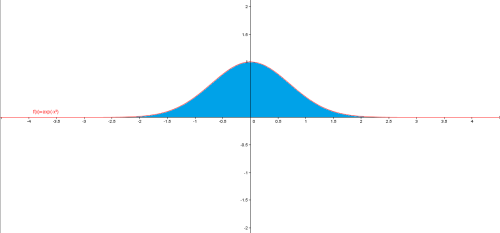Visualization Showing The Flow Of First 10,000 Digits Of Pi, Revealing How The Number Pi Looks Like.


Visualization showing the flow of first 10,000 digits of Pi, revealing how the number Pi looks like. Circle is divided in 10 segments, from 0 to 9. Then path is traced, going from the third segment to the first segment. From 1, the path jumps to 4, then back to 1, then 5 and so on. After a while, Pi appears in front of your eyes. The final illustration is beautiful.
More Posts from Vanderwaalrus and Others
Math Bro sent me this and I didn’t watch it before an exam and that was a huge mistake. Always watch this before math exams. It’s important.

For the first time, scientists have discovered a classic formula for pi in the world of quantum physics. Pi is the ratio between a circle’s circumference and its diameter, and is incredibly important in pure mathematics, but now scientists have also found it “lurking” in the world of physics, when using quantum mechanics to compare the energy levels of a hydrogen atom.
Why is that exciting? Well, it reveals an incredibly special and previously unknown connection between quantum physics and maths.
“I find it fascinating that a purely mathematical formula from the 17th century characterises a physical system that was discovered 300 years later,” said one of the lead researchers, Tamar Friedmann, a mathematician at the University of Rochester in the US. Seriously, wow.
The discovery was made when Carl Hagen, a particle physicist at the University of Rochester, was teaching a class on quantum mechanics and explaining to his students how to use a quantum mechanical technique known as the ‘variation principle’ to approximate the energy states of a hydrogen atom.
While comparing these values to conventional calculations, he noticed an unusual trend in the ratios. He asked Friedmann to help him work out this trend, and they quickly realised that it was actually a manifestation of the Wallis formula for pi – the first time it had even been derived from physics.
“We weren’t looking for the Wallis formula for pi. It just fell into our laps,” said Hagen. “It was a complete surprise,” added Friedmann. “I jumped up and down when we got the Wallis formula out of equations for the hydrogen atom.”
Since 1655 there have been plenty of proofs of Wallis’s formula, but all have come from the world of mathematics, and the new results have people freaking out. The results have been published in the Journal of Mathematical Physics.
Continue Reading.
When weather.com has advice for chem sophomores

life hack
want to see an entire class of physics students make the same hand gesture at once?
step 1: tell them that a charged particle is moving directly “out of the page”
step 2: tell them that a magnetic field points directly to the left
step 3: ask them what direction resultant force points if the particle moves through the field
step 4: watch the entire room start doing one of these numbers with their right hand in some of the most uncomfortable orientations humanly possible.


<3


The Gaussian Integral is a beautiful integral for which the area between the e^(-x^2) and the x-axis from negative infinity to positive infinity perfectly equals the square root of pi. Image sources: 1, 2.


http://smbc-comics.com/comic/rocks
I had some really nice asks about math encouragement, and so I wanted to share some things from my responses:
Since I was never a math person before my mid-twenties, I had a TON of catching up to do to get my mathematics degree. This meant I couldn’t afford to compare myself to my classmates, because I was so hilariously behind that I had to accept (and even embrace) being dead last in the ranking. I had to acknowledge that as a necessary pre-requisite to attempting a mathematics degree, and I truly believe that attitude is one of the main reasons I was able to complete that degree. Because of this attitude, I was kind to myself. I applauded myself for just being able to be in each room, enrolled in each class, because it was so improbable that a former math illiterate could have gotten there in the first place. I still endeavor to celebrate every victory from ‘Yay! You showed up with your shoes tied and everything’ to ‘Look at you go! You took that really hard test and got a WHOLE THIRD of the points! That so much more than none of the points!’ That mindset kept me going, kept me from being competitive with my colleagues, and kept me feeling fulfilled and proud of my work. I never was a modern-day Gauss, but that’s fine with me. I don’t do math to glorify myself. I do math because it is important, because I love it more than I have ever loved anything. I study mathematics because the only thing I need in this life is to know more about mathematics today than I did yesterday.

LHC Breakthrough Unveils Key Facts about the Fundamental Symmetry of Nature
These measurements may help physicists determine which theory of the Fundamental Laws of the universe is most plausible… http://bit.ly/1G0Eiic
-
 bloodmuffin reblogged this · 2 months ago
bloodmuffin reblogged this · 2 months ago -
 bloodmuffin liked this · 2 months ago
bloodmuffin liked this · 2 months ago -
 headlesssamurai liked this · 9 months ago
headlesssamurai liked this · 9 months ago -
 frankslittlevampire reblogged this · 11 months ago
frankslittlevampire reblogged this · 11 months ago -
 frankslittlevampire liked this · 11 months ago
frankslittlevampire liked this · 11 months ago -
 something-like-elation liked this · 1 year ago
something-like-elation liked this · 1 year ago -
 sharkman80 liked this · 1 year ago
sharkman80 liked this · 1 year ago -
 beehtrix reblogged this · 1 year ago
beehtrix reblogged this · 1 year ago -
 rentcellkebart liked this · 1 year ago
rentcellkebart liked this · 1 year ago -
 moosecakes liked this · 1 year ago
moosecakes liked this · 1 year ago -
 saturnev0id liked this · 1 year ago
saturnev0id liked this · 1 year ago -
 saturnev0id reblogged this · 1 year ago
saturnev0id reblogged this · 1 year ago -
 melodias-insonoras liked this · 2 years ago
melodias-insonoras liked this · 2 years ago -
 munixf liked this · 2 years ago
munixf liked this · 2 years ago -
 hardaslightningsoftascandlelight liked this · 2 years ago
hardaslightningsoftascandlelight liked this · 2 years ago -
 entrepreneurbaba24 liked this · 2 years ago
entrepreneurbaba24 liked this · 2 years ago -
 introverted-astrophile reblogged this · 2 years ago
introverted-astrophile reblogged this · 2 years ago -
 a-d-e liked this · 2 years ago
a-d-e liked this · 2 years ago -
 matrixofqualities liked this · 2 years ago
matrixofqualities liked this · 2 years ago -
 tuis-et-tibi liked this · 2 years ago
tuis-et-tibi liked this · 2 years ago -
 dirkdecker liked this · 2 years ago
dirkdecker liked this · 2 years ago -
 justdees liked this · 2 years ago
justdees liked this · 2 years ago -
 justdees reblogged this · 2 years ago
justdees reblogged this · 2 years ago -
 fearless-life-explorer liked this · 2 years ago
fearless-life-explorer liked this · 2 years ago -
 3mp3r0r liked this · 2 years ago
3mp3r0r liked this · 2 years ago -
 supergr8dayz liked this · 2 years ago
supergr8dayz liked this · 2 years ago -
 larklatroy liked this · 2 years ago
larklatroy liked this · 2 years ago -
 frenchpsychiatrybonbons reblogged this · 2 years ago
frenchpsychiatrybonbons reblogged this · 2 years ago -
 lexilagna liked this · 2 years ago
lexilagna liked this · 2 years ago -
 frenchpsychiatrybonbons liked this · 2 years ago
frenchpsychiatrybonbons liked this · 2 years ago -
 anightskiss liked this · 2 years ago
anightskiss liked this · 2 years ago -
 anightskiss reblogged this · 2 years ago
anightskiss reblogged this · 2 years ago -
 taediumvitaewe reblogged this · 2 years ago
taediumvitaewe reblogged this · 2 years ago -
 halfpoisonhalfgod reblogged this · 2 years ago
halfpoisonhalfgod reblogged this · 2 years ago -
 lockedroompuzzle liked this · 2 years ago
lockedroompuzzle liked this · 2 years ago -
 transluscent-gems liked this · 2 years ago
transluscent-gems liked this · 2 years ago -
 ultimatescapism reblogged this · 2 years ago
ultimatescapism reblogged this · 2 years ago -
 halfpoisonhalfgod liked this · 2 years ago
halfpoisonhalfgod liked this · 2 years ago